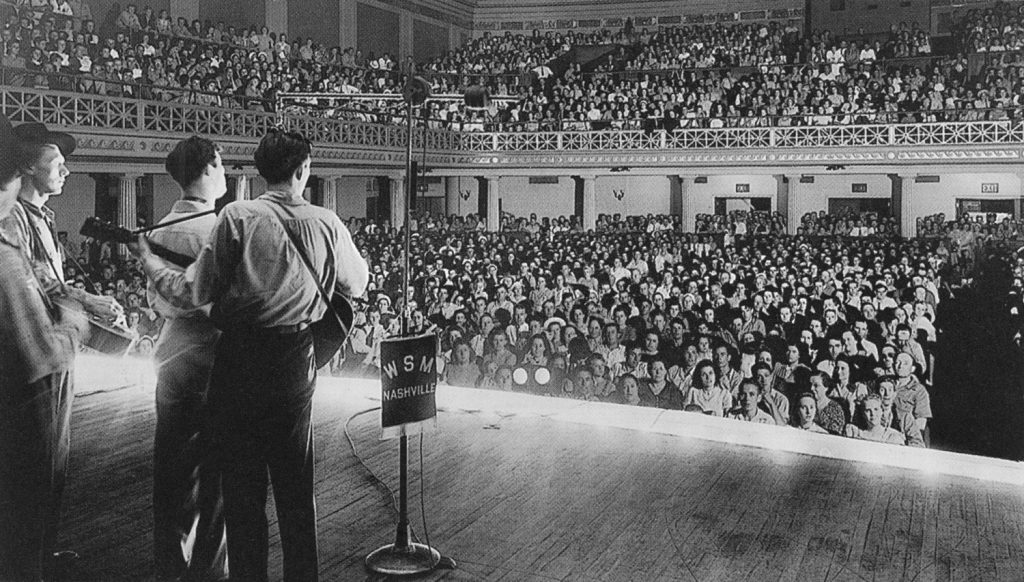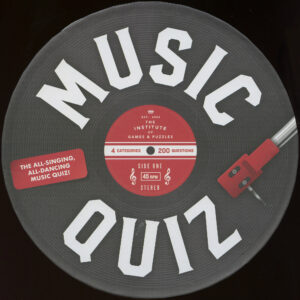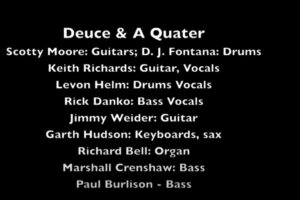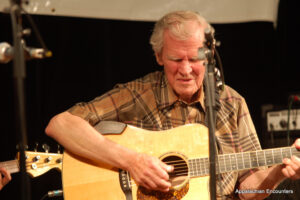One of the most important institutions in country music – and, therefore, American music – is the Grand Ole Opry in Nashville.
On October 18, 1925, the management of The National Life & Accident Insurance Company in Nashville premiered a program featuring “Dr. Humphrey Bate and his string quartet of old-time musicians.” Two weeks later, George D. Hay, who was a radio music pioneer who had worked on “National Barn Dance” on WLS in Chicago and for WMC in Memphis, was hired. Hay subsequently hired a 77-year-old fiddler named Uncle Jimmy Thompson. On November 25, The Grand Ole Opry was born in the fifth-floor radio studio owned by the insurance company. It initially was an hour-long barn dance program.

In addition to country music, The Grand Ole Opry features bluegrass, Americana, folk and gospel. There always has been a comedic performance element as well. For instance, Minnie Pearl — whose signature was a hat with the price tag hanging down — performed at the Grand Ole Opry for decades.
In the 1930s, the Opry expanded to four hours and WSM increased to 50,000 watts, which made it a powerhouse that helped provide the sound track to Saturday nights in almost 30 states. It went national on NBC in 1939. In 1943, the Opry moved to The Ryman Auditorium, the most famous of several permanent homes. Nashville became the heart of country music largely due to the presence of the Opry.
The profile says that regulars during its early days included Bill Monroe and bands with such great names as the Fruit Jar Drinkers, the Dixie Clodhoppers and the Gully Jumpers. The Fruit Jar Drinkers were a particularly important band. The first real star was Uncle Dave Macon, a banjo player from Tennessee.
The Grand Ole Opera didn’t have that famous name until December 10, 1927. Until then, “Barn Dance” was broadcast on the NBC Red Network after the “Music Appreciation Hour,” a program of classical music and opera featuring conductor Walter Damrosch. One night, he said that “There is no place in classics for realism.” I have no idea what that means, but it apparently was considered to be a shot at country music.
That generated a reaction from the folks at “Barn Dance.” George Hay made some comments countering what Damrosch said and introduced DeFord Bailey, who was known as the “Harmonica Wizard.” He said:
For the past hour, we have been listening to music taken largely from Grand Opera. From now on, we will present the “Grand Ole Opry.”
 It’s ironic that many great musicians are best known for odd or specialty numbers. It’s that way for the great Foggy Mountain Boys, who live on through “The Ballad of Jed Clampett,” which is the theme for “The Beverly Hillbillies” (on which they occasionally appeared). It’s especially ironic in this case because the program reinforced negative stereotypes of rural southerners. Check out the band’s The Complete Mercury Sessions at iTunes or click here or on the image for a Grand Ole’ Opry retrospective from Amazon.
It’s ironic that many great musicians are best known for odd or specialty numbers. It’s that way for the great Foggy Mountain Boys, who live on through “The Ballad of Jed Clampett,” which is the theme for “The Beverly Hillbillies” (on which they occasionally appeared). It’s especially ironic in this case because the program reinforced negative stereotypes of rural southerners. Check out the band’s The Complete Mercury Sessions at iTunes or click here or on the image for a Grand Ole’ Opry retrospective from Amazon.Wikipedia’s profile of the Grand Ole Opry continues through to today. In all, the Opry has had six homes and returns to the most famous, Ryman Auditorium, each year. The main home since 1974 has been The Grand Ole Opry House. All of the greats – from Elvis to Bill Monroe to Hank Williams to Pearl and so on – have performed at one or more of these venues.
A note at This Day in Country Music said that on February 22, 1969 The Grand Old Opry was the site of the last performance of the team of Lester Flatt and Earl Scruggs and their band, The Foggy Mountain Boys. The duo is a giant of bluegrass music that is best known for “The Ballad of Jed Clampett,” the theme song of “The Beverly Hillbillies.”
The Daily Music Break previously covered Flatt and Scruggs. Their lineage to bluegrass greatness is clear: Flatt had been a member of Bill Monroe’s band. He left and teamed with Scruggs. The Wikipedia entry is, for once, a bit hazy. It refers to “The Lester Flatt and Earl Scruggs Grand Ole Opry Show,” which was sponsored by grain and flour producer Martha White. It’s unclear if that was part of the overall Grand Ole Opry presentation, a distinct show or a bit of both.
The Foggy Mountain Boys epitomized good old time music. In that context, it’s interesting that Scruggs experimented on duets with King Curtis and added Bob Dylan songs to the band’s repertoire. That, according to The Boot, was at the heart of the band’s breakup. That story marks the breakup date as March 11, 1969. That doesn’t necessarily contradict This Day in Country Music, which noted the last appearance. The two were considering a reunion a decade later, but Flatt passed away in 1979.
Above is The Foggy Mountain Boys playing “Shuckin’ the Corn,” with Earl Scruggs featured. Below is interesting footage of Scruggs and Bill Monroe at the Grand Ole Opry.










